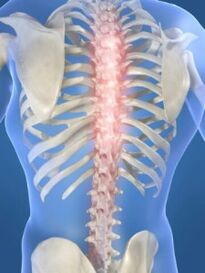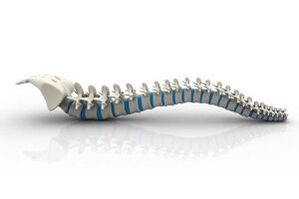Consider the symptoms of thoracic osteochondrosis, which are rare, since the spine is inactive in the chest area, firmly fixed to the ribs. The main reason for the development of symptoms is scoliosis, curvature of the spine. Manifestations and development of the disease are formed at an early school age.
The disease is often found in drivers, office workers, who for many years sat in awkward positions at a table who do not care about their posture. The thoracic spines are simultaneously bent with nerve fibers, ligaments, muscles throughout the patient's life. There is tension, pressure, extra load on the spine, this becomes the reason for the development of the disease.
Signs of thoracic osteochondrosis are differentiated from the symptoms identified. The disease is not pronounced, there is no acute persistent pain, there are unpleasant pains of a constantly painful nature. The doctor has difficulty diagnosing osteochondrosis of the chest. The symptoms are similar to gastroenterological diseases, the pain is similar to angina pectoris, myocardial infarction.
Symptoms

Osteochondrosis of the thoracic spine adversely affects the liver, kidneys, and adversely affects the functioning of the pancreas. It is often the cause of heart and intestinal disorders. The disease is manifested in different ways, there is no way to correctly distinguish the combination of symptoms, which makes it possible to correctly diagnose, in time - osteochondrosis of the chest region. Existence of characteristic symptoms:
- Unpleasant intermediate girdle pain, exacerbated by deep inspiration.
- Burning chest.
- Numbness of the upper extremities, pain when lifting.
- Unpleasant pain in the stomach, liver, heart.
- Gaining a body is difficult.
- In men, it becomes a cause of impotence.
The disease is characterized by strong, unpleasant intercostal pain. The patient has difficulty breathing, the pain increases with hypothermia, the body rotates. The pain becomes intense, unpleasant at night. Similar pain in the heart. With exacerbation of the disease in women, osteochondrosis radiates to the chest, contributing to abnormal changes in a woman’s breast. With exacerbation, severe pain lasts for several days.
Symptoms, treatment of osteochondrosis of the chest is determined by the complexity of the diagnosis, treated only by a doctor! Self-medication often leads to unintended consequences, complications and causes other diseases.
Dorsago and Dorsalgia
Osteochondrosis of the spine is accompanied by 2 vertebral syndromes:
- Dorsago. There is a sharp, sharp pain in the abdomen of those who work, folded for a long time. Severe pain occurs when climbing, which makes it difficult to breathe. Movement in the chest area is limited.
- Dorsalgia begins unnoticed, gradually. Discomfort, there is a slight pain that intensifies when the body bends, deep breathing.
It is indicated by muscle tension, which restricts movement: upper dorsalgia - in the cervix, lower - in the waist, chest. The pain intensifies with rest at night, gradually disappearing when walking in the morning. The pain gradually intensifies when a person sits in an awkward position for a long time.
Complications
Other manifestations of pain associated with the disease, which complicate the diagnosis, disorders:

- Upper chest segment - pain in the esophagus, pharynx, chest pain.
- Middle chest segment - pain occurs in the right hypochondrium, similar to gastroenterological diseases.
- Lower chest spine - a sudden sharp pain in the abdominal organs.
The pains are not seasonal, inaccuracies. Increased after physical activity. The pain sensations disappear after a whole night of rest, often disappearing completely.
If the disease is diagnosed and treated late, it becomes the cause of diseases, disorders of internal organs. Serious complication is the emergence of pathology, disorders of the coronary arteries of the heart, changes in the heart. Disorders occur in the duodenum, intestinal motility, gallbladder dyskinesia.
Diagnosis
The disease is poorly diagnosed. The symptoms of thoracic osteochondrosis are similar to those of angina pectoris, a myocardial infarction. With chest osteochondrosis, there is no relief from taking heart medications. The patient’s electrocardiogram is normal. The doctor makes the correct diagnosis of the disease when the patient is prescribed magnetic resonance imaging and X-ray examinations.
Treatment methods
The goal set by physicians during the implementation of basic therapeutic measures is to eliminate acute, excruciating pain in the curves of the spine, neurologically specific manifestations, and complete recovery of the patient. Treatment:
- Drugs;
- Exercise therapy;
- Physiotherapy.
Medical treatment begins with a doctor prescribing painkillers, anti-inflammatory drugs. Tablets for chest osteochondrosis - Baralgin. Physio-, manual therapy, exercise therapy is prescribed by a doctor.
The goal of physiotherapy is to improve blood circulation, cerebrospinal fluid. Muscle tension is relieved, the inflammatory process is reduced in the problem area, the pain is eliminated. Exercise therapy aims to prevent and treat the disease. Therapeutic exercises soothe, mobilize the deformed part of the spine.
The doctor prescribes exercise therapy in the acute period of the disease with a combination of muscle relaxation. Breathing exercises are prescribed after pain relief and disappearance. Reflex methods are used to treat osteochondrosis of the chest. The technique restores spinal mobility.
Acupuncture (acupuncture) aims to get rid of spasms, for muscle hypertension. With the help of acupuncture is carried out an effect that improves the work of blood vessels, has a beneficial effect on the blood supply, nourishes the tissues of the intervertebral discs.
The effectiveness of acupuncture increases with moxibustion, physiotherapy, blend massage, manual, vacuum therapy. The combination of disease treatment methods provides efficacy and safety. They are considered the basis of a strictly defined course for each patient.
With the help of effective methods, doctors are able to restore the normal functioning of the intervertebral discs of problem areas, stop progression, aggravation of thoracic osteochondrosis. Progressive methods of treatment stimulate the regeneration of the nuclear pulpus, annulus fibrosus disc.
Effective treatment technologies eliminate the unpleasant, uncomfortable sensations of the disease - pain, prevent complications of osteochondrosis, in the absence of treatment they appear in the form of protrusion, hernia.
For a patient with thoracic osteochondrosis, preventive, therapeutic saving gymnastics that complements the physician-prescribed medical therapy is important. It helps the patient to properly, competently form a muscular corset to prevent relapses, complications of the disease.

















































